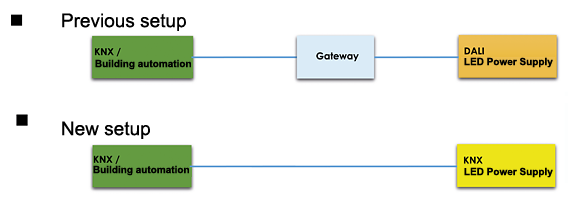
| DE | EN | Contact | About us | Terms of Business | Imprint | Privacy & Cookies | Help | Newsletter | Registration | Login | |
 |  |  |  |  |  |  |  |  |  |  |  |
| Home > News > Case Studies > Power Supplies > KNX: Integrating LED Switching Power Supplies Into Building Automation | |||||||||||
KNX: Integrating LED Switching Power Supplies Into Building AutomationSchukat provides the answers
Modern buildings often have a complex building automation system that controls heating, ventilation, blinds, access control and much more. Lighting plays a particularly important role in this. An intelligent control system can save up to 80% energy – if modern KNX systems are used.The ProblemThere is a vast number of LED power supplies on the market, but most do not have the prerequisites to integrate them directly into a KNX building automation system. Instead, for LED lighting, switch actuators and other devices are used. Why switch actuators?A KNX switch actuator forms an interface between a digital KNX system and analogue electrical devices. The actuator converts the commands received from sensors, automatic switches and timers into actions. The usual economical solution currently includes equipping a switch actuator with electromechanical relays, thus allowing any type of connected load to be switched.
What do I need to know about this? Integrate dimmable LED power supplies without a KNX interface?Another possibility is to integrate LED power supplies with an analogue 1-to-10V dimming interface by using a dimming actuator such as the KAA-4R4V-10 from MEAN WELL, or to integrate LED power supplies with a Dali interface into the KNX installation via a KNX-Dali gateway.
► Tip: MEAN WELL offers LED power supplies of this kind for constant voltage applications with 60W and 120W output power (PWM-120KN and PWM-60KN series)as well as for constant current applications with 25, 40 and 60W output power (LCM-25KN, LCM-40KN and LCM-60KN). Additional solutions, like the PWM-180KN, are currently in development. How big should the KNX devices be?Generally speaking, the installation of KNX devices, including the KNX power supply and switch actuators, often takes place in a switching cabinet inside a building. To ensure an integrated installation, the mechanical dimensioning of these devices should be done according to the DIN 43880 standard.
At SchukatSchukat electronic, as the largest European MEAN WELL distributor, offers their KNX products direct from stock. Our sales team will be happy to answer any questions you may have regarding KNX products, as well as the broader product portfolio – including classic LED power supplies, AC/DC top-hat rail power supplies, and complementary products such as inrush current limiters. |
|

